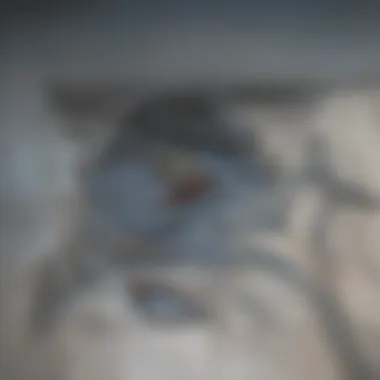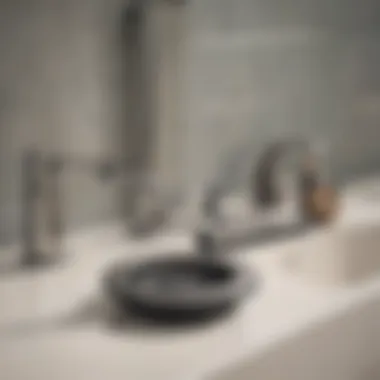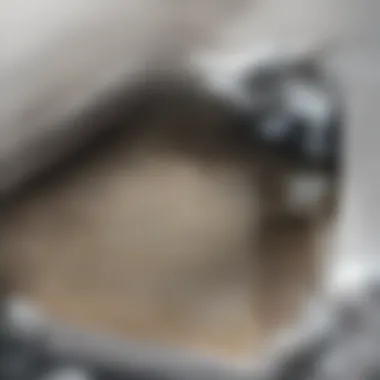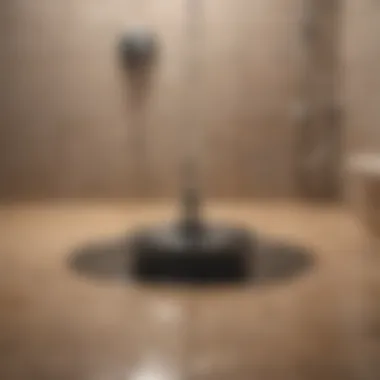Effective Techniques for Cleaning Shower Drains


Intro
Cleaning a shower drain clogged with hair is often seen as a tedious chore, yet it is vital for maintaining a hygienic home environment. Ignoring a clogged drain can lead to unpleasant odors and even serious plumbing issues. In this article, we will explore various effective techniques for clearing hair blockages in shower drains. This is not only about addressing the immediate problem but also about understanding preventive measures and maintenance tips to ensure your drainage system functions efficiently for years to come.
Feature Spotlight
Tools for Drain Cleaning
Effective cleaning begins with the right tools. Various implements can aid in the process, and knowing which tool is best suited for the job is crucial. Below are some of the most useful tools to keep on hand:
- Drain snake: This tool is designed specifically for removing hair and other debris from pipes.
- Plunger: A standard household tool that can sometimes effectively dislodge clogs.
- Wet/dry vacuum: This can clear large amounts of debris from drains without causing damage.
- Hair removal tool: A specialized tool designed to snag hair without damaging the pipes.
Effective Techniques for Unclogging
Once equipped with the right tools, it’s essential to know how to use them effectively. Here are several methods to address a clogged shower drain:
- Manual Removal: Start by removing the drain cover. You can often pull out hair and debris with your hands or a hair removal tool.
- Using a Drain Snake: Insert a drain snake into the drain. Twist and push it down to catch hair and other materials. Pull it out once you feel resistance.
- Plunger Action: For stubborn clogs, a plunger can be helpful. Cover the overflow drain and use the plunger over the clogged area until you feel the blockage release.
- Wet/Dry Vacuum: Set the vacuum to liquid mode, create a seal around the drain, and turn it on. This will pull a significant amount of debris from the line.
Maintenance Tips
Prevention is more effective than cure. Regular maintenance can help avoid hair-related issues in the first place:
- Use a Drain Cover: A simple mesh guard can catch hair before it enters the drain.
- Routine Cleaning: Regularly clean the drain by removing the cover and manually pulling out hair and other debris.
- Baking Soda and Vinegar: Pour a solution of baking soda followed by vinegar into your drain monthly. This can help prevent build-up.
"Regular maintenance not only avoids costly repairs but also enhances the overall bathing experience."
By adopting these simple yet effective methods, homeowners can maintain a clear shower drain while promoting better hygiene in their bathrooms. The next section will delve further into how to keep those drains functioning efficiently for the long run.
Understanding Shower Drain Clogs
Understanding shower drain clogs is vital for maintaining an efficient plumbing system and ensuring a hygienic bathing environment. Clogs can lead to unpleasant odors, slow drainage, and ultimately, costly repairs. By being informed about the common causes and signs of clogs, homeowners can take proactive measures to prevent blockages. This article not only outlines effective techniques for cleaning clogged drains but also emphasizes the importance of early detection and regular maintenance.
Common Causes of Clogs
Drains can become clogged for several reasons, most notably hair buildup. When hair strands accumulate over time, they can create a tangled mess that obstructs water flow. Additionally, soap scum, shampoo residue, and other debris can catch on the hair, exacerbating the problem. Other common causes include:
- Mineral deposits: Hard water can leave mineral buildup that narrows the drain.
- Foreign objects: Items accidentally dropped into the drain can cause serious blockages.
- Grease and residue: If hair care products or oils are washed down the drain, they can contribute to clogging.
Impact of Hair on Drainage Systems
Hair is one of the most persistent culprits in shower drain clogs. It can form a thick mat when combined with other substances, such as soap or skin cells. This obstruction not only restricts the flow of water but also leads to unpleasant odors arising from trapped waste. When hair accumulates, it can cause backups that lead to overflow, potentially damaging bathroom fixtures and flooring. Regular cleaning can reduce these effects and prolong the lifespan of drainage systems.
Signs of a Clogged Drain
Identifying the signs of a clogged drain early can save homeowners from more serious plumbing issues. Key indicators of a clogged shower drain include:
- Slow drainage: If water takes longer to flow down the drain, this is often the first sign of a problem.
- Unpleasant odors: Foul smells can indicate waste buildup in the pipes.
- Gurgling sounds: This noise can suggest that air is trapped due to obstructions.
- Overflowing: Water may back up into the shower if the clog becomes severe.
Taking note of these symptoms can help homeowners address issues promptly. In the following sections, we will explore various techniques and tools to effectively clean shower drains clogged with hair.


Preliminary Steps for Maintenance
Taking preliminary steps for maintenance is crucial when dealing with clogged shower drains, especially those clogged with hair. This phase sets the foundation for effectively addressing the issue and preventing future occurrences. A systematic approach can save time and effort, making maintenance a more manageable task.
Gathering Necessary Tools
Plumbing Snake
The plumbing snake, often referred to as a drain snake, is a flexible tool designed to clear clogs. Its primary role is to reach deep obstructions, allowing for efficient removal of hair and other debris. One of the key characteristics of a plumbing snake is its length and flexibility, enabling it to navigate through the bends of a pipe. This makes it a popular choice for homeowners when addressing shower drain clogs. The unique feature of the plumbing snake is the coiled steel design, which helps to latch onto hair and pull it out effectively. While advantageous for stubborn clogs, it does require some technique to avoid damaging pipes.
Drain Cleaning Agent
A drain cleaning agent is a chemical compound designed to dissolve clogs, making it easier to clear drains. Its key characteristic lies in its effectiveness; many agents utilize enzymes or acids to break down materials, including hair. This makes it a beneficial choice for homeowners seeking a quick solution with minimal physical effort. The unique feature of these agents is their varying formulations, which can cater to different types of clogs. However, there are disadvantages as well; some chemical agents can harm plumbing systems if used improperly or too frequently, necessitating caution during use.
Gloves and Mask
Using gloves and a mask should not be overlooked. They provide essential protection against irritants and bacteria that may be present in dirty drains. The key characteristic of gloves is their barrier property, which helps keep skin safe from chemical cleaners or the debris itself. A mask serves a similar purpose by protecting respiratory health from any fumes generated during cleaning. Employing these protective gear items is a practical and beneficial choice for anyone attempting to clear a clogged drain. The unique feature of gloves and masks is their availability in various sizes and materials, catering to different preferences. However, some might find it uncomfortable or difficult to wear them for extended periods, yet the safety they provide outweighs the minor inconvenience.
Safety Precautions
Prioritizing safety during drain cleaning is essential. Working with chemicals, sharp tools, and potentially hazardous materials necessitates a cautious approach. Always ensure good ventilation in the area, use gloves and masks as discussed above, and be mindful of the tools to avoid injury. Following these measures not only enhances personal safety but also ensures an effective and successful cleaning process.
Manual Removal Methods
Addressing shower drain clogs, especially those caused by hair, often requires a hands-on approach. Manual removal methods offer homeowners the advantage of not solely relying on chemical solutions that could potentially harm their plumbing systems. These techniques are not only effective but also allow individuals to see the exact cause of blockages. By understanding how to manually remove hair clogs, one can ensure a deeper clean and potentially avoid future issues.
Using a Drain Snake
The drain snake is a versatile tool essential for homeowners dealing with clogged shower drains. It is designed to navigate through the twists and turns of plumbing pipes. To use a drain snake, follow these steps:
- Insert the snake gently into the drain until you encounter resistance.
- Rotate the handle on the snake to latch onto the hair clog.
- Slowly pull the snake back, bringing the hair with it.
This method is beneficial because it physically removes the clog from the drain rather than pushing it further down the pipe. Additionally, it minimizes the risk of causing damage to the plumbing, making it an affordable solution to drain issues.
Applying a Hair Catcher Tool
Preventive measures are a smart way to enhance drain cleanliness. Using a hair catcher tool is an effective method to stop hair from entering the drain in the first place. Hair catchers are easy to use and come in various designs including mesh filters or silicone mats. To implement this method:
- Choose a hair catcher that fits snugly over your drain.
- Regularly clean the hair catcher after showers to ensure it remains effective.
By incorporating a hair catcher, homeowners can significantly reduce the likelihood of future clogs. Tending to the hair catcher regularly avoids extensive buildup in the plumbing.
Using Pliers for Grabbing Hair
In certain situations, hair can accumulate and create a visible clump near or at the drain's entrance. A simple pair of pliers can become an effective tool in this scenario. Here’s how to utilize this method:
- Put on gloves to protect your hands from debris and bacteria.
- Reach into the drain carefully with the pliers to grab any visible hair.
- Pull the hair out slowly and dispose of it properly.
This technique is straightforward and allows for quick removal without needing advanced tools. It also helps maintain hygiene in the bathroom. Each of these manual removal methods complements the overall strategy for keeping shower drains clear.
Implementing these techniques not only serves to address current clogs but fosters a conscientious approach to home maintenance that can benefit any household.


Chemical Solutions Utility
Addressing hair-clogged shower drains is crucial for maintaining an efficient drainage system. While manual removal methods have their place, chemical solutions offer alternative benefits. They can provide a more thorough clean and can often tackle stubborn clogs that might resist mechanical tools. By understanding the types of available drain cleaners, proper utilization, and their implications on the environment, homeowners can make informed choices.
Types of Drain Cleaning Chemicals
There are generally two primary categories of chemical drain cleaners:
- Caustic Drain Cleaners: These cleaners primarily use strong alkaline substances, usually sodium hydroxide or potassium hydroxide. They work by producing heat that dissolves organic matter such as hair and soap scum.
- Oxidizing Drain Cleaners: Composed of compounds like bleach or hydrogen peroxide, these cleaners interact with organic material through oxidation. They effectively break down hair and other residues.
Both types of cleaners can be very effective, but they function best under specific conditions. Like any tool, their effectiveness can depend on severity of clogging and the plumbing system's specifications.
How to Use Drain Cleaners
Using chemical solutions requires a methodical approach to ensure safety and effectiveness:
- Read Instructions: Always familiarize yourself with the product's guidelines. Each cleaner may have particular usage methods and safety precautions.
- Safety First: Equip yourself with gloves and goggles. Some chemicals can irritate skin and eyes. Ensuring proper ventilation is also key during application.
- Pouring Technique: Carefully apply the recommended amount of cleaner directly into the drain. For optimum effect, let it sit for the suggested time. If the product instructs stirring or flushing with water afterwards, be sure to follow that step.
- Check Results: After the designated time, flush the drain with hot water to see if the clog is cleared. If not, a second application might be necessary. However, do not exceed recommended dosages as this can lead to unintended consequences.
Environmental Impact of Chemicals
When discussing drain cleaners, it is crucial to consider their environmental effects. Many chemical drain cleaners contain powerful substances that can potentially harm the ecosystem when disposed of improperly. They can contribute to water pollution if they enter sewage systems unneutralized.
To mitigate these impacts, consider using eco-friendly alternatives or enzymatic drain cleaners that target blockages without harsh chemicals. These solutions often contain natural enzymes or bacteria that digest organic matter safely.
Maintaining Clear Shower Drains
Maintaining clear shower drains is crucial not just for immediate hygiene, but also for the longevity of the plumbing system. Clogged drains can lead to stagnant water, which can breed bacteria and unpleasant odors. Regular maintenance helps to prevent the accumulation of hair and soap scum, which are the leading causes of drainage issues. Furthermore, a well-maintained drain system can save homeowners significant amounts regarding plumbing repairs, as frequent clogs can lead to more serious plumbing problems over time.
Regular Cleaning Schedule
A regular cleaning schedule is essential. It ensures that even minor debris buildup is addressed before it develops into a more severe clog. Setting a specific day to clean the drain can establish a routine. A quick weekly check will allow you to remove any hair or debris visible in the drain cover. By incorporating a deep clean every month, you can use a drain cleaner or a plumbing snake to mitigate the chance for clogs.
Preventive Products
Hair Traps
Hair traps are an effective proactive measure when it comes to drain maintenance. These devices catch hair before it can slip down the drain, significantly reducing the chance of clogs. They come in various styles and materials, making them versatile for different shower types. A key characteristic of hair traps is their simplicity; they often require no tools for installation and allow for easy cleaning. However, one should remember to clear the trap regularly to prevent overflow situations.
Regular Cleaning Solutions
Regular cleaning solutions play a vital role in maintaining clear shower drains. These solutions often consist of safe, biodegradable ingredients that can break down and dissolve soap scum and hair buildup. What sets these products apart is their convenience; they can generally be used weekly without the need for heavy scrubbing or labor. However, over-reliance on chemical solutions can lead to issues. One should ensure that these products are actually eco-friendly and safe for plumbing systems, as more aggressive chemicals can cause deterioration of pipes over time.
Educating Household Members
Educating household members about drain maintenance can make a substantial difference. Sharing information on the importance of preventing hair from entering the drain can create awareness and encourage collaboration in keeping the drains clear. Engage in conversations about best practices for cleaning the bathroom and the role each family member plays in maintaining the drain. Simple measures—like brushing hair away from the drain or using the hair traps mentioned earlier—can greatly enhance the effectiveness of your cleaning regimen. Everyone should understand that their efforts contribute to a functional plumbing system.
"Prevention is better than cure; a little maintenance can go a long way."
By adhering to a regular cleaning schedule, utilizing preventive products, and educating those in your household, you can greatly reduce the chances of encountering serious drain issues in the future.
What to Avoid When Cleaning Drains


Cleaning shower drains clogged with hair is often a straightforward task. However, certain pitfalls can complicate the process or even lead to further issues. Recognizing what to avoid is crucial. Ignoring these elements can not only prolong your efforts but also damage your plumbing system. Consequently, understanding these missteps is vital for effective maintenance and avoiding costly repairs.
Common Mistakes
- Rushing the Process
Cleaning drains is not simpply about removing hair accumulation. It requires methodical steps. Many people rush through tasks and miss specific problematic areas. This neglect can result in residual blockages, leading to recurring issues. - Ignoring Safety Protocols
Safety should always come first. Some homeowners underestimate the dangers of chemicals often used in drains. Not wearing gloves or goggles can expose you to harmful substances. Make sure to follow safety recommendations carefully. - Using Inappropriate Cleaning Agents
Not all cleaning agents are suitable for all drain types. For instance, using caustic chemicals can damage pipes, especially older or plastic ones. Always read labels and choose products that align with your plumbing system. - Neglecting Routine Maintenance
Many homeowners refrain from regular cleaning until clogs occur. This approach creates more severe blockages. Establishing a routine for checking drain condition is essential to prevent future complications.
Wrong Tools for the Job
Utilizing the wrong tools is another frequent error when addressing clogged drains. Each tool serves a specific function. Choosing the wrong one can lead to inefficiencies or additional damage.
- Using Improper Size of Drain Snake
Drain snakes come in various sizes. Applying one that is too thick can cause damage to your pipes. Ensure to select a snake designed for your drain type. - Household Items That Should Not be Used
Some attempt to use makeshift tools like hangers or other objects. These alternatives often fall short and may end up breaking or getting stuck. Using manufactured tools designed for this task is preferable. - Chemical Cleaners Without Guidance
Many people assume all chemical cleaners are safe to use. However, numerous products can react badly, especially when mixed with others. Always follow instructions closely and do not combine different chemicals.
Always ensure you have the correct tools and cleaning agents. Taking shortcuts may lead to bigger problems that require professional intervention.
By avoiding these mistakes and using appropriate tools, your efforts to clear shower drains will be more effective. Proper knowledge in this area helps maintain a more efficient drainage system.
Seeking Professional Help
The decision to address a clogged shower drain can be an overwhelming one, especially when the blockage appears stubborn and resistant to common removal methods. This is where seeking professional help becomes essential. Professional plumbers possess not only the requisite training but also the tools and expertise necessary to tackle complex blockages effectively. Their insights can guide homeowners in making informed decisions about maintenance and potential upgrades to plumbing systems.
Hiring professionals to handle drain issues entails several benefits. Firstly, they can quickly identify the root cause of the problem, whether it is merely hair buildup or a sign of a more serious plumbing issue, such as corroded pipes. Understanding this distinction can save homeowners from spending unnecessarily on quick fixes that do not resolve underlying problems.
Moreover, professionals have access to advanced technologies that can make clearing drains faster and less disruptive. Hydro-jetting, for example, is a technique that utilizes high-pressure water to clear stubborn clogs. This method is often more effective than traditional snaking and does not require invasive procedures.
Maintenance is another critical aspect where professional help can be invaluable. Many plumbers offer routine inspections and cleaning services which can prevent future clogs from arising.
"An ounce of prevention is worth a pound of cure."
Ultimately, knowing when to call a professional is crucial. Sometimes, the best course of action is not attempting every DIY method available. Recognizing one's limits can lead to better outcomes and a healthier plumbing system.
When to Call a Professional
Identifying the correct moment to engage a plumbing professional can be pivotal. If a shower drain repeatedly becomes clogged despite attempts at cleaning and maintenance, this is often a red flag. Persistent drainage issues can indicate a blockage deep within the plumbing system that requires specialized equipment.
In addition, if homeowners notice other symptoms such as gurgling noises from drains or water backing up in other areas, these signs should not be ignored. These may point towards broader plumbing issues that could lead to severe damage if not addressed swiftly.
Occasionally, a systemic issue like tree root infiltration or significant sediment buildup is the source of repeated clogs. Such problems go beyond what typical home tools can handle. Consulting with a professional can help diagnose larger issues that may not be immediately apparent on the surface.
Cost Considerations
When contemplating professional plumbing services, cost is a significant factor. Prices can vary widely based on the complexity of the problem and the regional market. Some professionals may charge a flat fee for basic services, while others adopt a per-hour rate, particularly for extensive troubleshooting.
Homeowners may often find it beneficial to obtain multiple quotes before committing to any service. This practice not only provides insight into the average cost for the necessary repairs but also helps to gauge the experience of different professionals. Many businesses provide free estimates, offering a convenient way to weigh potential expenses.
Additionally, homeowners should consider the long-term savings associated with professional services. By preventing small issues from escalating into major repairs, the initial investment in professional help can lead to significantly less financial strain down the line.
Culmination
Cleaning shower drains clogged with hair is not simply a routine chore; it plays a crucial role in maintaining the overall functionality and hygiene of your bathroom. In this article, we explored various methods for effectively dealing with such clogs and emphasized the significance of addressing this issue promptly to avoid more severe plumbing problems in the future. Regular maintenance ensures that your drainage systems function efficiently, which helps prevent the accumulation of unwanted odors and possible water damage.
Final Thoughts on Drain Maintenance
Maintaining clear and functional shower drains requires consistent attention and effort. Implementation of simple techniques like regular cleaning schedules and the use of preventive measures, such as hair traps, can significantly reduce the likelihood of future clogs. Educating all household members about these practices increases the likelihood of successful outcomes.
In summary, taking proactive measures is far less costly and time-consuming than dealing with backed-up drainage systems. By understanding the composition of hair and how it interacts with the plumbing system, one can make informed choices about cleaning methods and products.
"Prevention is better than cure." Adopt best practices for drain maintenance to keep your bathroom functioning smoothly and free of clogs.







